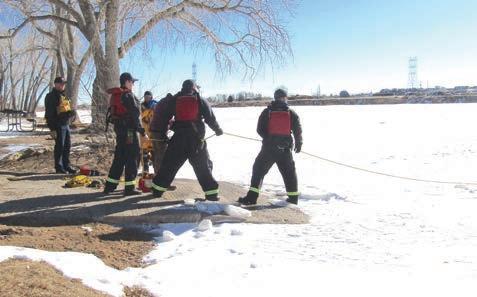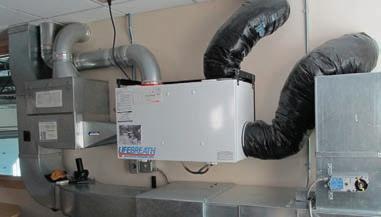
6 minute read
MOCK RESCUE
the yearly training. He estimated that West Metro Fire responds to several calls a year.
Scholting added that animals more often than people fall through the ice, e LPD said in the statement that no criminal activity is suspected in relation to her death. and the department would rather have people call rst responders to help rather than trying to do the rescue themselves.
Patricia Dilworth had last been seen Jan. 5. Her family contacted the police to do a welfare check as they were concerned for her safety after not hearing from her, LPD said in the same statement. A missing person’s alert was sent out when it was found that she was not home, and according to the LPD, they had been doing multiple searches since.
Loupee said the training allows reghters to use consistent tactics and to make sure the equipment is functioning properly.
“We make sure we’re ready if the need arises,” Loupee said.
Advertisement
Firefighters are ready to pull on a rope to extricate a person from a hole in the ice at Bear Creek Lake Park during a mock exercise.
Understanding Indoor Air Quality and How It’s Handled in Super-Insulated Homes
As we all work to make our homes more airtight, we also have to be conscious of our families’ need for fresh air — oxygen above all! If our homes were completely airtight, we would not only risk suffocation, we would also be more susceptible to the toxic gases and fumes being emitted by our paint, our carpeting, our gas appliances, and more.
The outgassing from our carpet and other building materials are known as “volatile organic compounds” or VOCs.
An appliance which you’ll be hearing more about in homes like your own as our buildings become better insulated and therefore more airtight is displayed schematically in the third column.
It’s called an Energy Recovery Ventilator (ERV) or a Heat Recovery Ventilator (HRV). Below that schematic is a picture of an ERV installed in a home.
Before I explain this appliance’s operation, let me tell you what it replaces: the exhaust fans in your bathrooms and above your kitchen stove. Those exhaust fans simply pump air out of you house, which causes fresh air to be sucked into your house via the gaps around your doors and windows and multiple other gaps you are not aware of.
That air which enters your home is not preconditioned in any way. It is whatever the temperature is outdoors, and in midwinter it could make your furnace work harder heating the cold air which naturally enters your home, whether or not

How to Recognize Scam Emails and Phone Calls
Senior citizens in particular are targets for scammers. It’s easy to be taken in by a scam email or phone call, so here are some tips on how to recognize them. I’m not an expert on this topic, but I’m speaking from my own experience. I have never been a victim of a scam because I’m careful. I’m sharing with you the care I take to avoid scammers.
If you do end up speaking with or exchanging emails with a scammer, remember this above all else: If it sounds too good to be true, it’s a scam. If they ask for any personally identifying information, it’s a scam. If they ask for money, it’s a scam. Better yet, though, it’s important to recognize the emails so you don’t open them and scammers’ phone numbers so you don’t answer them. If they pretend to be from your bank, etc., hang up and call your bank or whoever.
Scam emails: The main danger with emails occurs when you open an attachment or click on a link that contains a virus. Never click on a link or attachment you are not expecting. For attachments, look at the file name. If the suffix is “.htm” or “.html” it’s a website, not an attachment, and it will capture your information and suck you in. Word files (“.doc” or “.docx”) can also contain hidden links in them that capture your information or plant a virus on your computer. An Acrobat file (“.PDF”) might be safe, but I wouldn’t open one I’m not expecting from a trusted person. If the PDF asks you to enter something instead of opening immediately, you know it’s a scam or virus, so don’t do it!
Look at the email address of the sender, but more importantly, float your cursor over the address to see what the sender’s real email address is, because it could be different. That’s a red flag. Look at the suffix on the email address. If it’s not those exhaust fans are operating.

“.com” or “.net” or “.org” or “.edu” or “.gov” it might be for a foreign country –another red flag. If it says the attachment is a voicemail, or an invoice, or “payment advice,” that attachment is probably a website and it’s a scam. If you have opened an email and the whole message is one link because wherever you float the cursor you see the finger pointer instead of the arrow pointer, that’s a red flag. Close the email and delete it! If there are links in an email, float your cursor over the link without clicking on it, and see if it’s the same. For example, the link might look legitimate, such a “microsoft.com,” but when you float over it you see some other address, probably ending in a country code (“.uk” or “.ru” etc.) that’s a red flag. Close and delete the message! If you do visit a website, float over any link within that website for the same reason.

Phone calls and text messages: It’s best to let unknown numbers go into voicemail, then check your voicemail. Usually a scammer won’t leave a voicemail, so don’t think you missed anything important. Look at the phone number. Never answer an “unknown” number or a number from another country or a number from “United States” instead of a specific city. If you answer the phone and the person uses your legal first name instead of your nickname, and if they ask how you are today instead of just saying hello, they’re either a solicitor or a scammer. You don’t need to be polite. No need to say good-bye, just hang up.
On text messages, use the same advice as above. Don’t click on a link. You can ignore text messages. If it’s a real person, they’ll call you if you don’t respond. Above any text message will be an icon for the sender. Touch it and the word “Info” to learn more about who it is.
Thus, the primary job of the ERV or HRV is to use the heat from the air being exhausted from your home to preheat the air that is entering your home without having those two sources of air mix with each other. This is done through what is referred to as a heat exchanger. In the above concerned about indoor air quality, this is the device you’ll want to look into purchasing for your home. diagram, the heat exchanger is in the middle of the device. The unit runs at low speed, taking the stale air from your bathrooms and kitchen (typically), through a metallic heat exchanger which then adds that heat to the air which is passing through the adjoining passageway from the outdoors into your living spaces. That fresh air replenishes the oxygen in your home.
Whereas the ERV and HRV may operate on an as-needed basis, the CERV is intended to run 24/7, constantly monitoring the level of CO2 and VOCs in your indoor air as it is drawn through the unit. If the levels of these or other pollutants are high, the unit’s fan will run faster. A recent update of the unit has the addition of a viruskilling UV light.
Also, a CERV contains a heat pump, so it can actually perform the function of a furnace, preheating the air which is drawn from outdoors or recirculated through the house, not merely transferring the room temperature heat from the exhausted air to the incoming air.
What I have described above is the function of the HRV, which only handles the transfer of heat from one air source to the other. The ERV also performs the transfer of humidity. Thus, if the cold air outside your house is very dry (typical of Denver’s climate), the ERV will transfer some of the moisture from the indoor air to the incoming air.
Neither the ERV nor the HRV measure or react to the presence of toxic gases in your home. That’s the added value of a third device, the CERV or Conditioning Energy Recovery Ventilator. If you’re
I have written in the past about the Geos Community in Arvada. None of the homes in that community use natural gas. Instead, the townhomes are heated and cooled by a combination of a heat pump/mini-split system and a CERV which provides additional heating or cooling. The detached homes at Geos also have CERVs to complement the ground source heat pumps which provide the primary year-round heating and cooling of the homes.
2022’s Top Producer Is Named
Congratulations to David Dlugasch, our top-producing Broker Associate for 2022! During last year he sold $5,625,700 worth of listings and represented buyers in the purchase of $5,278,900 worth of listings.
Since joining Golden Real Estate in October 2014, David has closed 47 listings and assisted buyers in closing on another 39 listings. He moved to Arvada from Crested Butte, where he owned his own brokerage, choosing to affiliate with Golden Real Estate because he was regular online reader of this very column (Denver Post version). Thanks, David, for being one of our hardest working and most consistently productive broker associates.
Learn more about CERVs at www. BuildingEquinox.com. The local vendor is AE Building Systems, 720-287-4290 Jim




